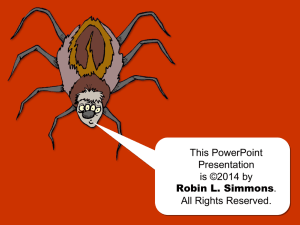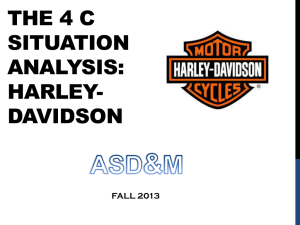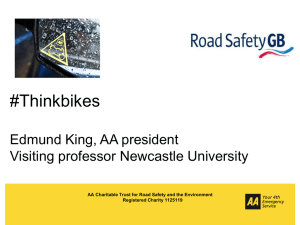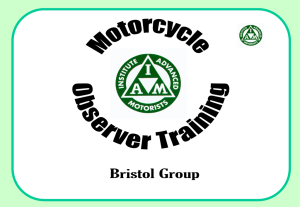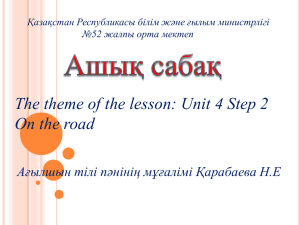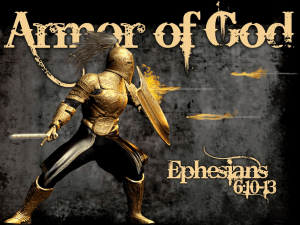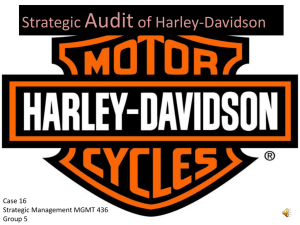Motorcycle Safety & Laws
advertisement
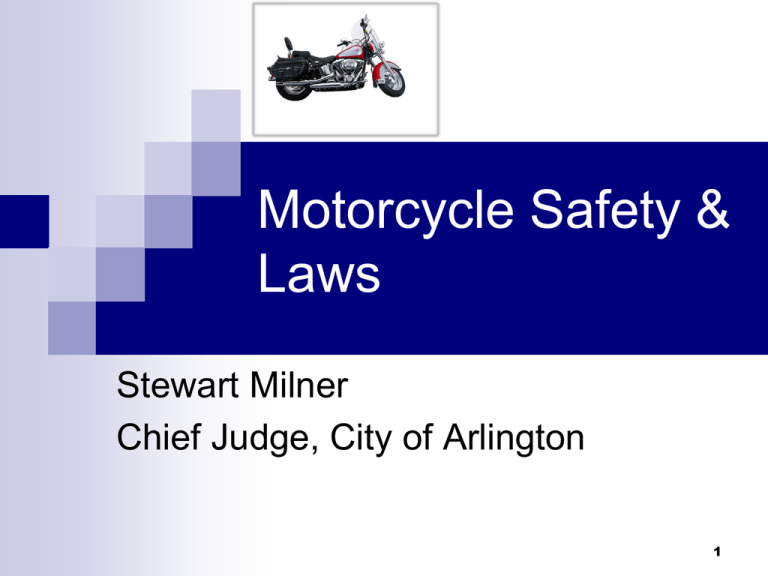
Motorcycle Safety & Laws Stewart Milner Chief Judge, City of Arlington 1 Who are licensed motorcycle riders? You and Me –Anyone over 15! Motorcycle sales have increased for the last 11 years. From 1997 to 2010 motorcycle registrations in the United States have increased by 70%. 12 million license holders nationwide. 90% are male. 2 Fastest growing segment is in the 40-60 year old age group. 3 Why are more people Riding? Recreation Cost Saving Sport - Thrill 4 Motorcycle Safety Issues and Facts Motorcycle crash fatalities rose every year from 2000- 2009. Fatalities in Texas tripled from 2007-2009. 96,000 motorcycle crashes in the U.S. in 2008 resulted in injuries. A cyclist is 37 times more likely to die in a crash and 9 times more likely to be injured in a crash than passenger car occupants. 5 1. Safety What percentage of Riders involved in fatal Motorcycle crashes are over 40 years old? A. 25% B. 10% C. 33% D. 50% 6 Safety – Cont’d 50% of motorcycle riders killed in crashes are over 40 years of age. 29% of motorcycle operators involved in fatal crashes were legally intoxicated, compared to 23% of fatal passenger car crashes. 7 2. Safety What percentage of motorcycle operators involved in fatal crashes did not have a valid motorcycle endorsement on their license? A. 40% B. 25% C. 63% 8 Safety – Cont’d 25% of motorcycle operators involved in fatal crashes did not have a valid motorcycle license. Brain Injuries, Head Trauma were the leading cause of death in motorcycle crashes. 9 Safety – Cont’d In 2008, 35 percent of all motorcyclists involved in fatal crashes were speeding. In 2008 motorcycle helmets saved 1,829 lives. Helmets are believed to be 37 % effective in preventing fatal injuries. 90% of motorcycle operators killed are male. 10 What IS a Motorcycle? It is a motor vehicle designed to propel itself with no more than three wheels in contact with the ground. It is equipped with a rider’s saddle. It is a motor driven cycle. (Less than 250cc’s) It is a moped. (Transp. Code §541.201). 11 Motorcycle 12 What is a Motorcycle – Cont’d It is: an enclosed three-wheeled passenger vehicle that is designed to operate with three wheels in contact with the ground with a minimum unladen weight of 900 lbs and has a single, completely enclosed occupant compartment with seats, a steering wheel and propulsion unit in front of or behind the enclosed occupant compartment with seatbelts for each occupant, and a windshield and windshield wipers and, 300 or more are produced each year. 13 14 What is NOT a Motorcycle! It is not an electric bicycle. (Transp. Code § 541.201) It is not a pocket bike, mini-motor bike or motorized mobility device or neighborhood electric vehicle. 15 Not a Motorcycle 16 License Requirements A person is required to have a motorcycle license or class M endorsement on their license to operate a motorcycle or moped on public roadways. There are four types of motorcycle licenses. The most common is an unrestricted Class M. 17 License Requirements 18 Types of Class M Licenses Class M – no restrictions, any type of motorcycle or moped. Class M with restriction code I – any moped or motorcycle with an engine displacement of less than 250 cc. Class M with restriction code K – any moped 50 cc or less with a top speed of 30 m.p.h. Class M with restriction code J – licensed m/c operator over 21y.o.a. in sight 19 Types of Class M Licenses Class M with restriction code I – any moped or motorcycle with an engine displacement of less than 250 cc. Must be at least 15 year of age or older, Complete and Pass a motorcycle operator training course, Pass a road skills test, but No school enrollment requirement. When license holder turns 16, the 250cc restriction is lifted. 20 Types of Class M Licenses Class M with restriction code K – any moped 50 cc or less with a top speed of 30 m.p.h Must be at least 15 year of age or older, Pass a written traffic laws knowledge test (applicable to mopeds), However, no road skills test is required, and No school enrollment requirement. 21 Getting an Unrestricted Motorcycle License Requires: Knowledge Test Vision Test Motorcycle Safety Course 22 3. Motorcycle Safety Course The motorcycle safety course used as a substitute for a Driver’s Safety Course is not the same as the motorcycle safety course used when obtaining a license? A. True B. False 23 4. Motorcycle Safety Course The Motorcycle Safety Course used for D.S.C and for obtaining a license is not the same as the Motorcycle Safety Course that can be used in exempting a motorcycle rider from wearing protective headgear? A. True B. False 24 Riding Skills Test v. Motorcycle Safety Course Riding Skills Test longer allowed or required – Motorcycle safety course is now required However, the law authorizing motorcycle road skills test is still there. (Texas Trans. Code Sec. 521.166) No 25 Motorcycle Safety Course Required to obtain a Class M endorsement Applicants must complete a Department of Public Safety Approved Basic Motorcycle Operator Training Course. 26 Financial Responsibility Financial responsibility is required for motorcycles just as it is for other vehicles. 27 Helmets – Required or Not? 28 5. Helmets – Required or Not? It is against the law for someone over 21 y.o.a. to ride a motorcycle on a public street in Texas without wearing a helmet? A. True B. False 29 Helmets – Required or Not? A person in Texas commits an offense if he operates a motorcycle and doesn’t wear an approved helmet. Really? 30 Helmet Law Exceptions It is an exception to Sec. 661.003 if: The person required to wear the helmet, at the time of the offense, was over 21years of age, and Had successfully completed a motorcycle operator training and safety course, Or Had a health insurance policy that provides at least $10,000.00 in coverage for injuries sustained as a result of an accident on a motorcycle. 31 Helmets Sticker for helmet exemption no longer required. NHTSA estimates that motorcycle helmets reduce the likelihood of a crash fatality by 37 percent. Helmets are 67 percent effective in preventing brain injuries. 32 33 Helmet Laws Three general schemes found in U.S. law – all riders must wear helmets Partial Laws (Weakened Law) – Those under 18 or 21 must wear a helmet, other riders have restrictions No helmet requirement at all. Universal 34 35 Helmets The year after Texas went from a universal helmet law to a weakened helmet law – motorcycle operator fatalities increased by 31 percent. Hospital costs from motorcyclists injured in accidents were less than $10,000 in only 25% of the cases. 36 Helmet s Helmets must be DOT approved. There are helmets that do not meet approval. There is not a specific violation for this but a person could be charged with using non DPS approved equipment. 37 Other Safety Equipment Eye Protection – most states require Gloves – leather or other non-slip material are best Jackets and Trousers – Clothing should help in the event or a crash. Footwear- should afford protection for feet, ankle and lower part of leg 38 39 Motorcycle Safety & Awareness Class Class requirements governed by statute. Class is 16 hours long. Will substitute for D.S.C. if violation committed while operating motorcycle. Will allow rider to ride without helmet. 40 Motorcycle Safety & Awareness Class Provisions, guidelines and requirements for class are found in Chapter 662 of the Texas Transportation Code. Fee is typically $190. It is a 16 hour class. 41 Motorcycle Safety Trends & Innovations ? 42 Miscellaneous Laws & Rules Have to pay toll but not more than cars. Motorcycles can use the HOV lanes even if only occupied by the driver. Passengers must wear helmets unless exemption applies. Motorcycles must be inspected and registered to operate on a public street. 43 Miscellaneous Laws & Rules Must be at least 5 years old to ride as a passenger on a motorcycle unless riding in a side car. Fine range $100 to $200. 44 Share the Road! The Motorcycle, not so much. 45 46
